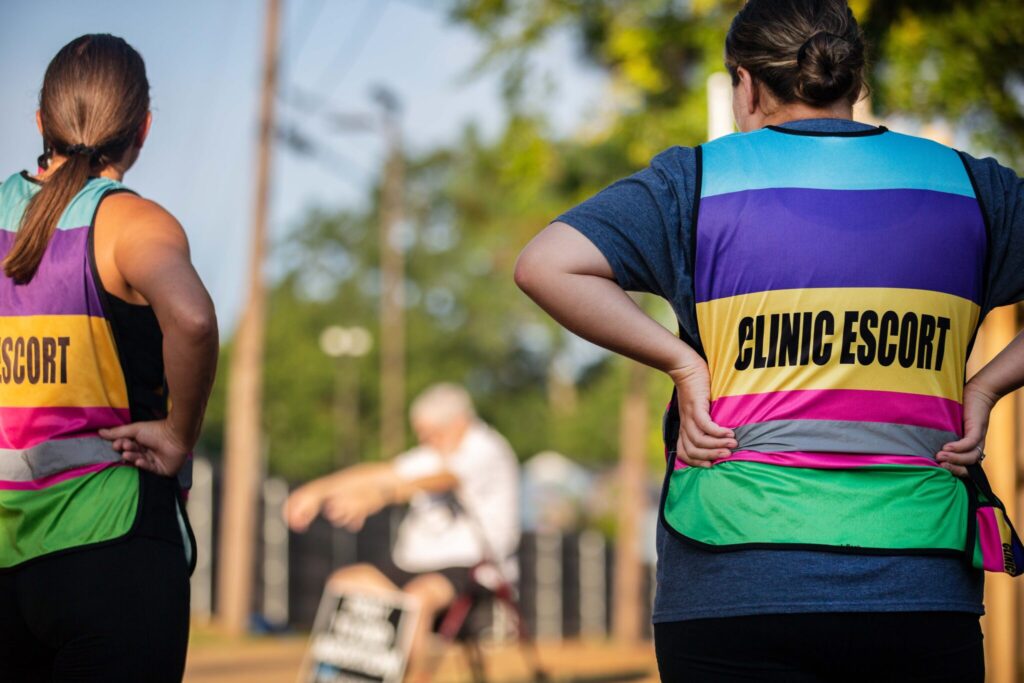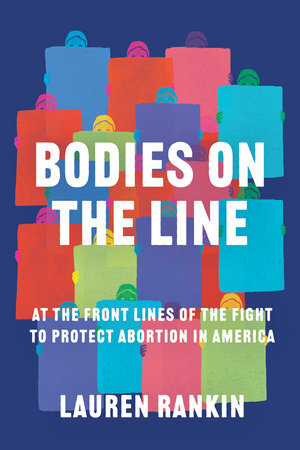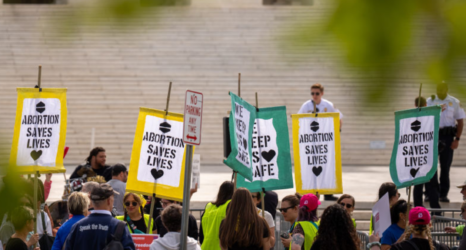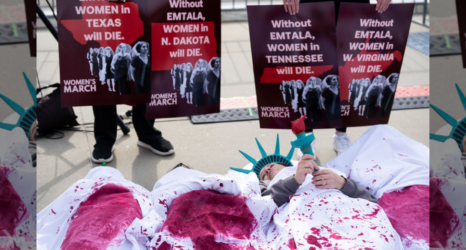Bodies on the Line by Lauren Rankin examines the role of clinic escorts in America’s fight for abortion rights, and chronicles the history of anti-abortion extremism.

Dandy Barrett was soaking wet when she found out her father had been murdered. In the middle of a shower, her phone started ringing and she stepped out to answer it. Her brother was on the other line. “Dad’s been shot at the Ladies Center,” he told her through tears. “He’s dead, Dandy.”
Barrett’s father, James, was an Air Force veteran, community volunteer and friendly septuagenarian. He was also a clinic escort at his local women’s health center in Pensacola, Fla. In this position, James Barrett and his wife, June, walked patients and doctors to the clinic entrance—past throngs of virulent ant-abortion protesters—providing a safe haven for people seeking legal abortion services. Barrett viewed his volunteering as a natural extension of his military career spent protecting citizens. He was only able to offer this critical assistance for a mere 16 months, however, before being shot by an anti-abortion terrorist on July 29, 1994. That day marked the first time in U.S. history that a clinic escort was killed while volunteering.
This personal account appears in Lauren Rankin’s new book, Bodies on the Line: At the Front Lines of the Fight to Protect Abortion in America. In the book, Rankin, a writer and expert on abortion rights, traces the history of clinic escorts and defenders in the U.S. from the earliest days of legalized abortion in the 1970s through the present day, when the prospect of the overturning Roe v. Wade hovers over the nation like a specter.
Upon the nationwide legalization of abortion in 1973, longtime abortion rights activists like Carol Downer celebrated their hard-won victory while clinics began breaking ground across the country. Immediately on the heels of this success, however, were groups of newly organized anti-abortion protesters ready to fight.
Their actions started relatively quietly: In 1975, a group of six women entered a clinic in Rockville, Md., and staged a silent sit-in. Other groups handed out literature in parking lots. But then came the megaphones, the screaming, the death threats and the outright violence.
By the end of the 1970s, feminists, activists and community members had already come together in response to growing numbers of protesters, forming ad hoc clinic escort teams across the country.
“It sounds absurd in its simplicity—just walk with people,” wrote Rankin, “but that’s what makes it so radical.”
By providing patients with a comforting shoulder to lean on, a kind word to hear and a clear passage to the front door, a clinic escort lends a humanizing presence to an oft-chaotic scene. Clinic escorts are key to making “abortion access a reality,” said Rankin, who also volunteered as a clinic escort in New Jersey for six years.
Throughout the 1980s and early 1990s, anti-abortion groups like the Pro-Life Action League and Operation Rescue began to hold coordinated, large-scale demonstrations across the nation, forming blockades in front of clinic entrances; gluing locks shut; writing down patients’ license plate numbers; engaging in intrusive “sidewalk counseling” sessions; lying in front of vehicles; yelling in patients’ faces through megaphones; and locking themselves to lab equipment and doors.
Their actions started relatively quietly. But then came the megaphones, the screaming, the death threats and the outright violence.
Abortion providers, administrators, clinic escorts and patients began to fear for their lives. And rightly so: Anti-abortion protesters proved their capacity for violence again and again. Bombings, arson, kidnapping and murder were all committed by extremist anti-abortion activists. Essentially, these groups “turned the front door of a clinic into a carnival of chaos,” wrote Rankin.
Despite these escalating tactics—many of which were downright illegal—the response from law enforcement and legislators was tepid. Even after the passage of the Federal Access to Clinic Entrances (FACE) Act in 1994, which provided federal protection to patients entering clinics, police remained largely untrained and were leery of getting involved. In cases when picketers were arrested for their actions, they were often fined only small amounts and immediately released—in some instances, directly onto buses which brought them back to the clinic protests.
“Ultimately, [clinics and patients] were often left to their own devices,” wrote Rankin, “knowing that law enforcement was reluctant or even unwilling to come out and deal with an isolated incident of individualized harassment.”
As a result, clinic escort teams were forced to evolve alongside the increasingly fractious and threatening behavior of abortion opponents. Clinic defense emerged. Unlike escorts, defenders took a more aggressive role with anti-abortion protesters, engaging directly with them and attempting to distract them so that escorts could safely usher patients inside clinics. At the same time, strategies employed by clinic supporters were more widely shared and standardized across the U.S.
The impact of coordinated regional and national defense efforts was manifold. After the “Summer of Mercy” in 1991—which brought 25,000 anti-abortion protesters to Wichita, Kan., where they wreaked havoc for several weeks—abortion rights activists organized by Buffalo United for Choice came from across the country to defend clinics in Buffalo, New York during the so-called “Spring of Life” in 1992. Protesters were unable to shut down a single clinic in the city because of the robust response of escorts and supporters, causing Time magazine to refer to the anti-abortion group’s effort as “Operation Fizzle.”
Although the work of clinic escorts and defense teams has been overwhelmingly successful, what came next in the battle for abortion rights has proven more difficult to counteract. President George W. Bush “helped usher in a new era of institutionalizing opposition to abortion,” wrote Rankin, referring to Bush’s appointment of abortion opponents Chief Justice John Roberts and Justice Samuel Alito to the Supreme Court as well as the passage of the Partial Birth Abortion Ban Act during his term.
The slow erosion of abortion rights in the past decade is a logical and insidious evolution of the work started all those decades ago in Rockville, Md., when six women staged a sit-in at one of the first abortion clinics in the country.
Mass protests against abortion rights increased under Barack Obama’s presidency and “helped trigger the beginning of the most restrictive decade for abortion rights in recent memory,” Rankin said. Donald Trump’s election in 2016 energized anti-abortion groups, who recognized Trump’s opportunity to nominate additional abortion opponents to the Supreme Court, which he subsequently did with Justice Neil Gorsuch, Justice Brett Kavanaugh and Justice Amy Coney Barrett.
As well, the past few years have seen myriad anti-abortion legislation enacted throughout the country, including Targeted Regulation of Abortion Provider (TRAP) laws, which impose medically unnecessary regulations on abortion clinics with the intention of shutting them down. Rankin wrote, “Abortion opponents finally found something that could end legal abortion without overturning Roe: forcing clinics to close.”
Clearly, this strategy has worked for opponents. Today, 89 percent of U.S. counties lack an abortion clinic, according to the Guttmacher Institute, despite the majority of Americans supporting the legalization of abortion. The consequences of this lack are felt most deeply by women of color, families with low income and rural-dwelling individuals, all of whom are often forced to travel long distances—sometimes crossing state lines—at great expense in order to access safe healthcare.
The slow erosion of abortion rights in the past decade is a logical and insidious evolution of the work started all those decades ago in Rockville, Md., when six women staged a sit-in at one of the first abortion clinics in the country. “It has happened slowly, under our noses, for decades,” wrote Rankin. Bodies on the Line makes that abundantly clear.
The idea of cardiac hospitals or dialysis centers being blockaded by thousands of protesters is so absurd it beggars belief, yet we’ve come to accept the chaos outside of women’s clinics as “normal.” Why?
Rankin’s research for the book is methodical and exhaustive. She includes interviews with more than 60 clinic escorts from groups such as the Pink House Defenders, the Washington Area Clinic Defense Task Force, the Illinois Choice Action Team and many more. The work of support groups everywhere from North Dakota to New York is profiled. By not engaging in discursive debates and wild speculation on politics and legislation, Rankin keeps the book focused on the human-level experience of escorts and patients. The story of abortion access is the story of people, after all.
At one point in the book, Rankin calls the work of clinic escorts a “job that shouldn’t be necessary at all.” The idea of cardiac hospitals or dialysis centers being blockaded by thousands of protesters is so absurd it beggars belief, yet we’ve come to accept the chaos outside of women’s clinics as “normal.” Why?
The truth is that the right to an abortion has never been truly safe. The fight for women’s healthcare didn’t end with the ruling in Roe v. Wade, it didn’t end with the confirmation of abortion rights with Planned Parenthood v. Casey and it won’t end now, no matter the outcome of Dobbs v. Jackson Women’s Health Organization.
“For just as long as there has been legal abortion in the U.S., there has been a dedicated and concerted effort to undermine it,” wrote Rankin. Luckily, we have people like Rankin and all the clinic escorts profiled in her book putting their bodies on the line every day.
Sign and share Ms.’s relaunched “We Have Had Abortions” petition—whether you yourself have had an abortion, or simply stand in solidarity with those who have—to let the Supreme Court, Congress and the White House know: We will not give up the right to safe, legal, accessible abortion.
Up next:






